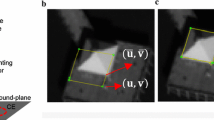Abstract
Recent growth of the geospatial information on the web has made it possible to easily access a wide variety of spatial data. The ability to combine various sets of geospatial data into a single composite dataset has been one of central issues of modern geographic information processing. By conflating diverse spatial datasets, one can support a rich set of queries that could have not been answered given any of these sets in isolation. However, automatically conflating geospatial data from different data sources remains a challenging task. This is because geospatial data obtained from various data sources may have different projections, different accuracy levels and different formats (e.g., raster or vector format), thus resulting in various positional inconsistencies. Most of the existing algorithms only deal with vector to vector data conflation or require human intervention to accomplish vector data to imagery conflation. In this paper, we describe a novel geospatial data fusion approach, named AMS-Conflation, which achieves automatic vector to imagery conflation. We describe an efficient technique to automatically generate control point pairs from the orthoimagery and vector data by exploiting the information from the vector data to perform localized image processing on the orthoimagery. We also evaluate a filtering technique to automatically eliminate inaccurate pairs from the generated control points. We show that these conflation techniques can automatically align the roads in orthoimagery, such that 75% of the conflated roads are within 3.6 meters from the real road axes compared to 35% for the original vector data for partial areas of the county of St. Louis, MO.
Similar content being viewed by others
References
M.-F. Aculair-Fortier, D. Ziou, C. Armenakis, and S. Wang. “Survey of work on road extraction in aerial and satellite images, Universite de Sherbrooke,” Technical Report, 2000.
J. Astola, P. Haavisto, and Y. Neuvo. “Vector median filter,” in Proceedings of IEEE, April, 1990.
T. Barclay, J. Gray, and D. Stuz. “Microsoft terraserver: A spatial data warehouse,” in Proceedings of the 19th ACM SIGMOD International Conference on Management of Data, 2000.
M.D. Berg, M.V. Kreveld, M. Overmars, and O. Schwarzkopf. “Computational geometry: Algorithms and applications,” Springer: Berlin Heidelberg New York, Vol., 1997.
C.-C. Chen, C.A. Knoblock, C. Shahabi, Y.-Y. Chiang, and S. Thakkar. “Automatically and accurately conflating orthoimagery and street maps,” in Proceedings of the 12th ACM International Symposium on Advances in Geographic Information Systems (ACM-GIS’04), pp. 47–56, Washington, DC, ACM, November 12–13, 2004.
C.-C. Chen, C. Shahabi, and C.A. Knoblock. “Utilizing road network data for automatic identification of road intersections from high resolution color orthoimagery,” in Proceedings of The Second Workshop on Spatio-Temporal Database Management(STDBM’04) colocated with VLDB, Toronto, Canada, August 30, 2004.
C.-C. Chen, S. Thakkar, C.A. Knoblok, and C. Shahabi. “Automatically annotating and integrating spatial datasets,” in Proceedings of the International Symposium on Spatial and Temporal Databases, Santorini Island, Greece, 2003.
M. Cobb, M.J. Chung, V. Miller, H.I. Foley, F.E. Petry, and K.B. Shaw. “A rule-based approach for the conflation of attributed vector data,” GeoInformatica, Vol. 2(1):7–35, 1998.
S. Filin and Y. Doytsher. “A linear conflation approach for the integration of photogrammetric information and GIS Data,” International Archives of Photogrammetry and Remote Sensing, Vol. 33:282–288, 2000.
M. Flavie, A. Fortier, D. Ziou, C. Armenakis, and S. Wang. “Automated updating of road information from aerial images,” in Proceedings of American Society Photogrammetry and Remote Sensing Conference, 2000.
D. Forsyth and J. Ponce. Computer Vision: A Modern Approach. Prentice-Hall, 2001.
M.F. Goodchild and G.J. Hunter. “A simple positional accuracy measure for linear features,” International Journal of Geographic Information Sciences, Vol. 11(3):299–306, 1997.
A. Habib, R. Uebbing, and A. Asmamaw. “Automatic extraction of road intersections from raster maps,” Technical Report, The Center for Mapping, The Ohio State University, 1999.
W.A. Harvey. “Performance evaluation for road extraction,” The Bulletin de la Societe Francaise de Photogrammetrie et Teledetection, Vol. 153(1999-1):79–87, 1999.
C. Heipke, H. Mayer, and C. Wiedemann. “Evaluation of automatic road extraction,” IAPRS, International Society for Photogrammetry and Remote Sensing, Vol. 32(3-2(W3)), 1997.
H. Hild and D. Fritsch. “Integration of vector data and satellite imagery for geocoding,” International Archives of Photogrammetry and Remote Sensing, Vol. 32, 1998.
S. Hinz, A. Baumgartner, C. Steger, H. Mayer, W. Eckstein, H. Ebner, and B. Radig. “Road extraction in rural and urban areas,” Semantic Modeling for the Acquisition of Topographic Information from Images and Maps, 1999.
M. Jones and J. Rehg. “Statistical color models with application to skin detection,” in Proceedings of IEEE Conf. on Computer Vision and Pattern Recognition, 1999.
M. Kass, A. Witkin, and D. Terzopoulos. “Snakes: Active contour models,” International Journal of Computer Vision, Vol. 1, 1988.
R. Nevatia and K.R. Babu. “Linear feature extraction and description,” Computer Graphics and Image Processing, Vol. 13:257–269, 1980.
K. Price. “Road grid extraction and verification,” International Archives of Photogrammetry and Remote Sensing, Vol. 32(Part 3-2W5):101–106, 1999.
A. Saalfeld. “Conflation: Automated map compilation,” International Journal of Geographic Information Sciences, Vol. 2(3):217–228, 1988.
A. Saalfeld. Conflation: Automated map compilation, Ph.D. Dissertation, Computer Vision Laboratory, Center for Automation Research, University of Maryland, 1993.
E.L. Usery, M.P. Finn, and M. Starbuck. “Data integration of layers and features for the national map,” in Proceedings of American Congress on Surveying and Mapping, Phoenix, Arizona, 2003.
V. Walter and D. Fritsch. “Matching spatial data sets: A statistical approach,” International Journal of Geographic Information Sciences, Vol. 5, 1999.
M.S. White and P. Griffin. “Piecewise linear rubber-sheet map transformation,” The American Cartographer, Vol. 12(2):123–131, 1985.
C. Wiedemann, C. Heipke, and H. Mayer. “Empirical evaluation of automatically extracted road axes,” in Proceedings of 9th Australasian Remote Sensing and Photogrammetry Conference, Sydney, 1998.
S. Yuan and C. Tao. “Development of conflation components,” in Proceedings of Geoinformatics, 1999.
Author information
Authors and Affiliations
Corresponding author
Rights and permissions
About this article
Cite this article
Chen, CC., Knoblock, C.A. & Shahabi, C. Automatically Conflating Road Vector Data with Orthoimagery. Geoinformatica 10, 495–530 (2006). https://doi.org/10.1007/s10707-006-0344-6
Received:
Revised:
Accepted:
Published:
Issue Date:
DOI: https://doi.org/10.1007/s10707-006-0344-6




